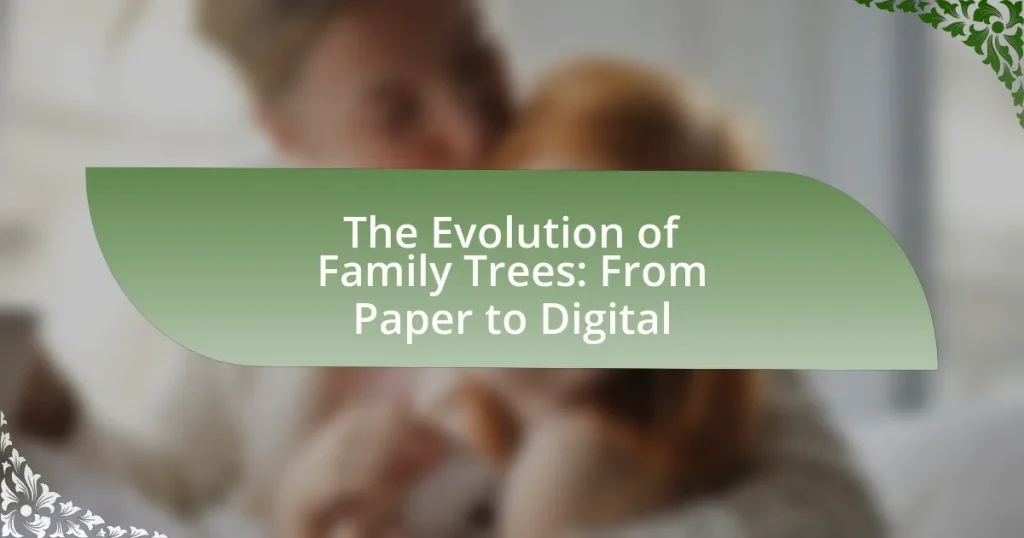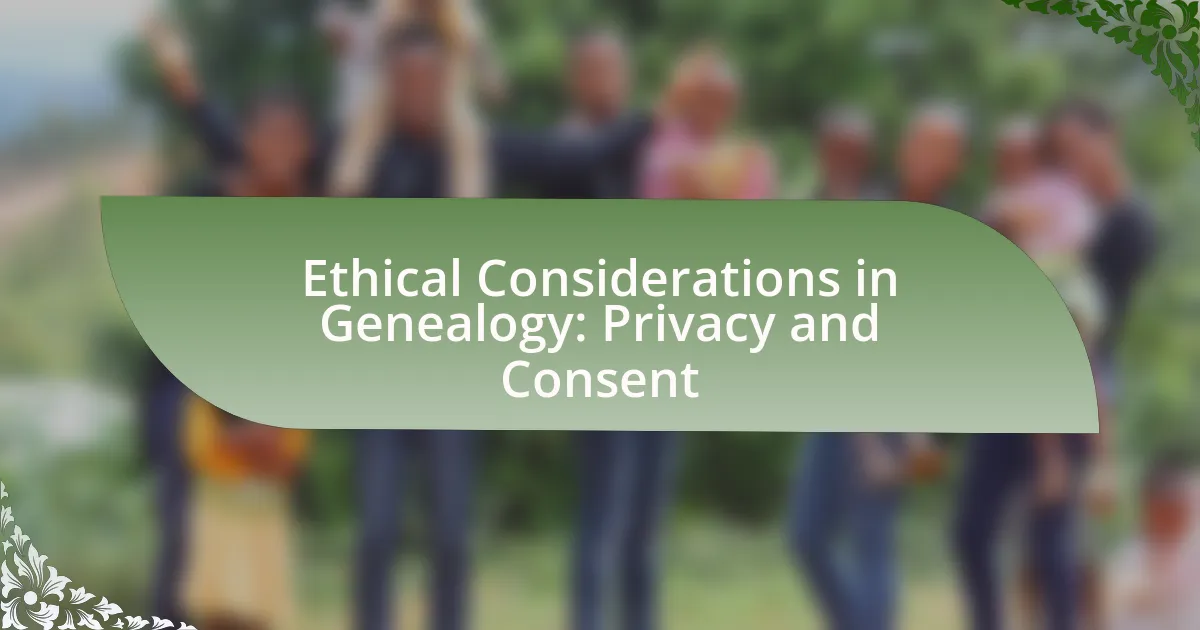The article examines the evolution of family trees, highlighting the transition from traditional paper-based formats to digital representations. It discusses the historical significance of family trees, their cultural influences, and the impact of technology on genealogical research. Key topics include the advantages of digital tools for accessibility and collaboration, the role of DNA testing in uncovering familial connections, and the ethical considerations surrounding privacy and data sharing. The article also outlines best practices for creating and maintaining accurate family trees in the digital age.
What is the Evolution of Family Trees?
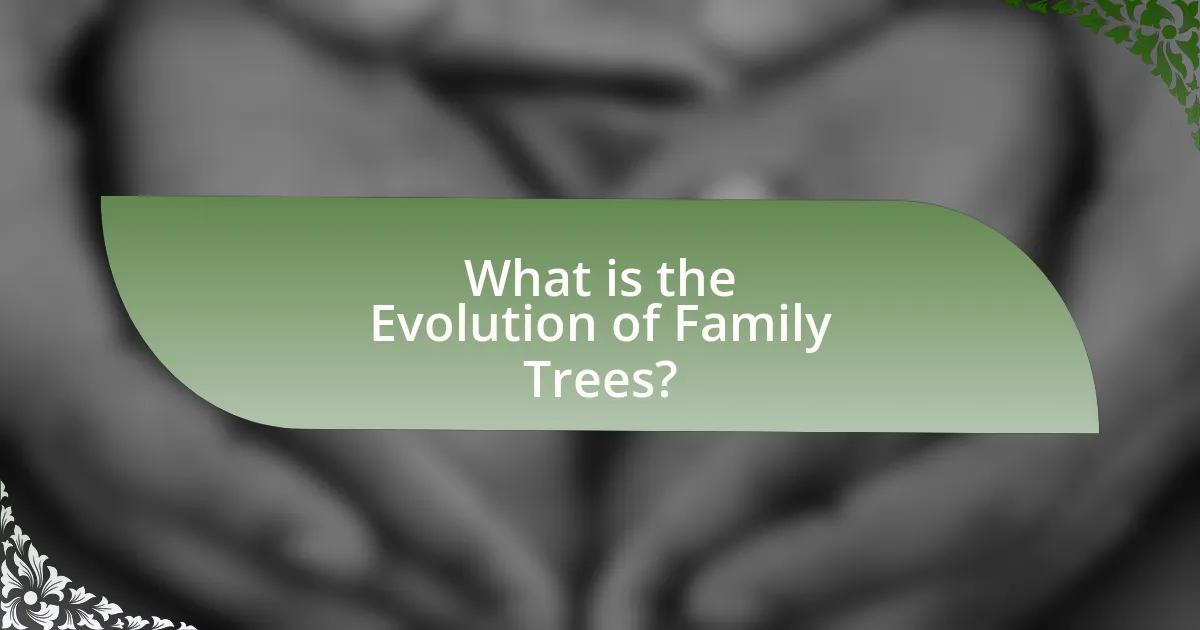
The evolution of family trees has transitioned from traditional paper-based representations to digital formats. Initially, family trees were hand-drawn or recorded in books, often limited by space and the availability of information. With the advent of technology, genealogical research became more accessible, leading to the development of software and online platforms that allow users to create, share, and expand their family trees efficiently. Digital tools enable the integration of vast databases, such as census records and historical documents, facilitating more comprehensive genealogical research. This shift has significantly enhanced the accuracy and reach of family tree construction, allowing individuals to connect with distant relatives and uncover ancestral histories that were previously difficult to trace.
How have family trees changed over time?
Family trees have evolved significantly from traditional paper formats to digital representations. Historically, family trees were hand-drawn or printed on paper, often limited by space and the complexity of family relationships. With the advent of technology, digital family trees emerged, allowing for more extensive and intricate representations of lineage. Digital platforms enable users to easily add, edit, and share information, facilitating collaboration among family members and researchers. Additionally, advancements in genetic testing have introduced a new dimension to family trees, enabling individuals to uncover biological connections that may not have been documented in traditional records. This shift from paper to digital has transformed how families document their heritage, making it more accessible and comprehensive.
What were the earliest forms of family trees?
The earliest forms of family trees were simple diagrams or charts that visually represented familial relationships, often created on parchment or paper. These early family trees date back to ancient civilizations, such as the Egyptians and Mesopotamians, who documented lineage for purposes of inheritance and social status. For instance, the ancient Egyptians used hieroglyphics to record family connections, while the Mesopotamians created clay tablets that outlined genealogies. These methods laid the groundwork for more complex family trees developed in later cultures, emphasizing the importance of ancestry in societal structures.
How did cultural influences shape family tree designs?
Cultural influences significantly shaped family tree designs by dictating the visual representation and structural organization of genealogical information. For instance, in Western cultures, family trees often adopt a linear format, emphasizing direct ancestry, while in many Asian cultures, such as Chinese and Japanese, family trees may include multiple branches to represent extended family and lineage, reflecting the importance of ancestral heritage. Additionally, indigenous cultures may incorporate symbols and colors that represent tribal affiliations and spiritual beliefs, further diversifying the design elements. Historical practices, such as the use of scrolls in ancient Egypt to document lineage, also illustrate how cultural contexts have influenced the methods and aesthetics of family tree representation.
Why is the evolution of family trees significant?
The evolution of family trees is significant because it reflects the changing ways in which individuals and societies understand and document lineage and relationships. Historically, family trees were primarily recorded on paper, which limited accessibility and sharing. The transition to digital formats has enabled broader participation in genealogy, allowing for easier collaboration, data sharing, and the integration of diverse sources of information. For instance, platforms like Ancestry.com and MyHeritage have transformed family history research by providing vast databases and user-friendly tools, leading to increased interest in ancestry and heritage. This shift not only enhances personal connections to history but also contributes to the preservation of cultural identities and collective memory.
What insights do family trees provide about ancestry?
Family trees provide insights into ancestry by illustrating familial relationships and lineage across generations. They reveal connections between individuals, helping to trace heritage and understand genetic backgrounds. For example, a family tree can show how many generations back a particular ancestor lived, which can be crucial for genealogical research. Additionally, family trees often highlight patterns of migration, marriage, and inheritance, offering a comprehensive view of how family dynamics have evolved over time. This information is supported by genealogical studies that emphasize the importance of lineage in understanding cultural and historical contexts.
How do family trees reflect societal changes?
Family trees reflect societal changes by illustrating shifts in family structures, cultural norms, and demographic trends over time. For instance, the increasing prevalence of blended families, single-parent households, and same-sex partnerships in family trees indicates changing societal attitudes towards marriage and family dynamics. Historical data shows that in the early 20th century, extended families were more common, while recent statistics reveal a rise in nuclear families, highlighting urbanization and mobility. Additionally, family trees can reveal patterns of migration and ethnicity, showcasing how societal changes influence family lineage and connections across generations.
What are the key differences between paper and digital family trees?
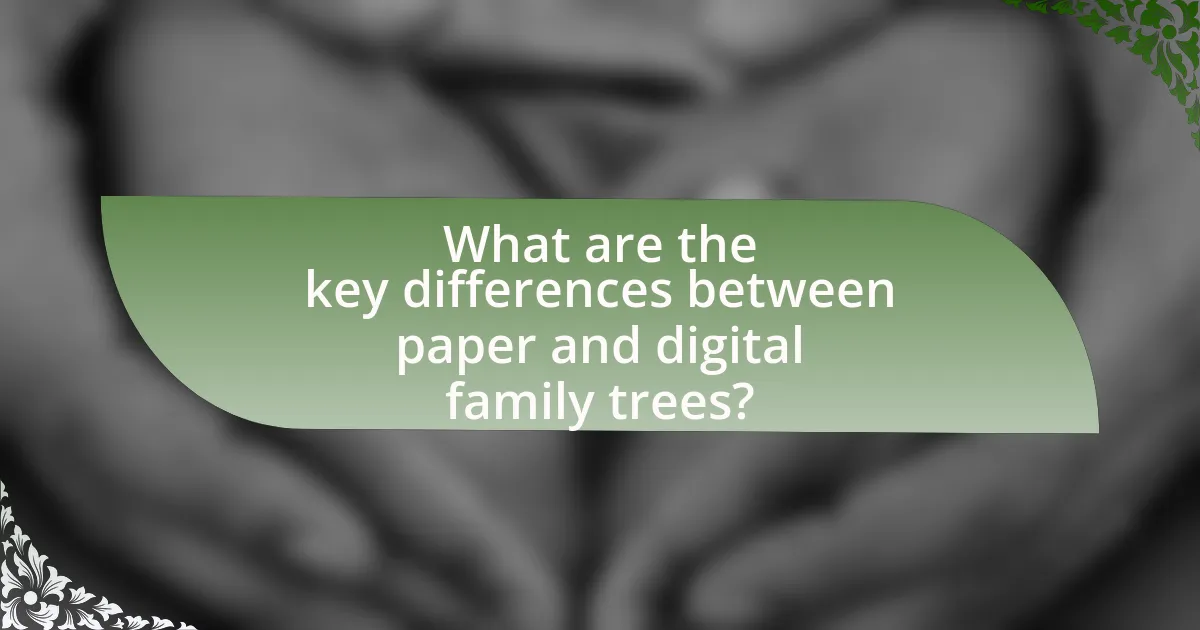
The key differences between paper and digital family trees lie in accessibility, ease of editing, and storage capacity. Digital family trees can be accessed from multiple devices and locations, allowing for real-time updates and collaboration, while paper family trees are static and require physical storage. Digital formats enable users to easily edit and rearrange information, whereas changes to paper trees necessitate manual corrections or complete rewrites. Additionally, digital family trees can store vast amounts of data, including multimedia elements, while paper trees are limited by physical space. These distinctions highlight the advantages of digital family trees in terms of functionality and user experience.
How does the accessibility of family trees differ between formats?
The accessibility of family trees varies significantly between paper and digital formats. Digital family trees offer enhanced accessibility through online platforms, allowing users to easily share, edit, and collaborate in real-time, while paper formats are limited to physical copies that can be cumbersome to distribute and update. For instance, online genealogy services like Ancestry.com provide tools for searching historical records and connecting with other users, which is not possible with traditional paper trees. This shift to digital formats has been supported by statistics indicating that over 70% of genealogists now use online resources, highlighting the preference for digital accessibility over paper.
What challenges do users face with paper family trees?
Users face several challenges with paper family trees, primarily related to space limitations and the difficulty of updating information. Paper family trees can become unwieldy as more generations are added, making it hard to maintain a clear and organized structure. Additionally, when new information arises, such as discovering new relatives or correcting errors, users must manually alter the tree, which can lead to confusion and inaccuracies. The static nature of paper also means that users cannot easily share or collaborate on their family trees, limiting the ability to gather input from other family members.
What advantages do digital family trees offer in terms of accessibility?
Digital family trees provide enhanced accessibility by allowing users to access their family history from anywhere with an internet connection. This digital format eliminates the limitations of physical storage, enabling multiple users to view and edit the family tree simultaneously. Additionally, digital family trees often include features such as search functions, multimedia integration, and mobile compatibility, which further facilitate easy navigation and engagement with family history. These advantages make it simpler for individuals to connect with their ancestry and share information across generations.
What tools are available for creating digital family trees?
Various tools are available for creating digital family trees, including software applications and online platforms. Popular options include Ancestry.com, which offers extensive genealogical records and user-friendly tree-building features; MyHeritage, known for its DNA testing and family tree construction; and FamilySearch, a free service provided by The Church of Jesus Christ of Latter-day Saints that allows users to build and share family trees. Additionally, software like Family Tree Maker and Legacy Family Tree provides offline capabilities for detailed family history documentation. These tools facilitate the organization and visualization of family relationships, making genealogy more accessible and efficient.
Which software options are popular for digital family tree creation?
Popular software options for digital family tree creation include Ancestry, MyHeritage, FamilySearch, and Legacy Family Tree. Ancestry is widely recognized for its extensive database and user-friendly interface, allowing users to build and share family trees easily. MyHeritage offers unique features like photo enhancement and colorization, appealing to users interested in visual family history. FamilySearch is a free platform that provides access to a vast collection of genealogical records, making it a valuable resource for researchers. Legacy Family Tree is known for its robust reporting features and customization options, catering to more advanced users. These software options are frequently recommended due to their comprehensive tools and resources for family history research.
How do online platforms enhance collaboration in family tree building?
Online platforms enhance collaboration in family tree building by providing tools that allow multiple users to contribute, edit, and share genealogical information in real-time. These platforms facilitate communication among family members, enabling them to discuss findings, share documents, and upload photos, which enriches the family history. For instance, platforms like Ancestry.com and MyHeritage offer features such as shared family trees, messaging systems, and collaborative research tools, which streamline the process of gathering and verifying information. This collaborative approach not only increases the accuracy of the family tree but also fosters a sense of community among users, as they can collectively explore their heritage and connect with distant relatives.
What trends are shaping the future of family trees?
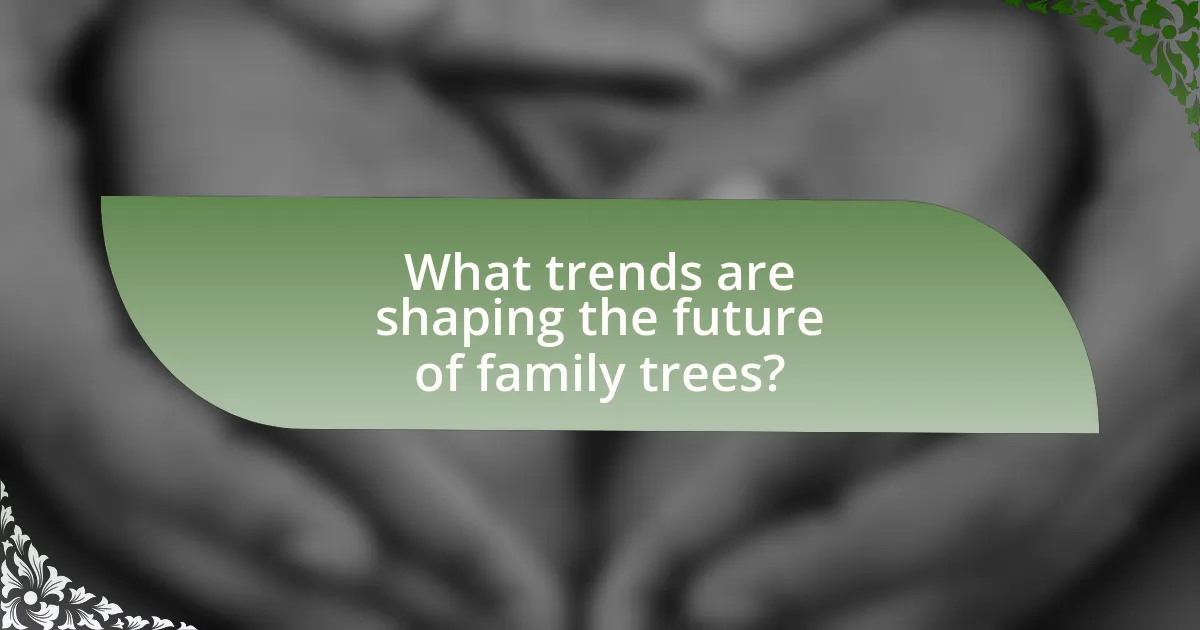
The future of family trees is being shaped by digitalization, genetic genealogy, and collaborative platforms. Digitalization allows for easier access and sharing of family history information, enabling users to create and update family trees online. Genetic genealogy, through DNA testing, provides deeper insights into ancestry and familial connections, enhancing traditional family tree research. Collaborative platforms facilitate community engagement, allowing users to work together on shared family histories, which increases the accuracy and richness of the data. These trends reflect a shift towards more interactive, accessible, and scientifically informed approaches to understanding family lineage.
How is technology influencing family tree research?
Technology is significantly influencing family tree research by providing advanced tools and platforms that streamline data collection and analysis. Digital genealogy databases, such as Ancestry.com and MyHeritage, allow users to access vast amounts of historical records and connect with other researchers, enhancing the accuracy and depth of family trees. Additionally, DNA testing services like 23andMe and AncestryDNA offer genetic insights that can reveal familial connections and ancestral origins, further enriching family history research. The integration of these technologies has transformed traditional methods, making it easier for individuals to trace their lineage and discover their heritage.
What role do DNA tests play in modern family tree construction?
DNA tests play a crucial role in modern family tree construction by providing genetic evidence that can confirm or refute familial relationships. These tests analyze an individual’s DNA to identify genetic markers that are shared with relatives, allowing for the discovery of previously unknown connections and the verification of existing family ties. For instance, a study published in the American Journal of Human Genetics found that DNA testing can reveal biological relationships that traditional genealogical research may overlook, such as non-paternity events or adoptions. This genetic information enhances the accuracy of family trees and enables individuals to trace their ancestry with greater confidence.
How are social media platforms impacting family tree sharing?
Social media platforms are significantly enhancing family tree sharing by facilitating easier communication and collaboration among family members. These platforms allow users to share genealogical information, photos, and stories, which can lead to the discovery of new relatives and connections. For instance, a study by the Pew Research Center found that 69% of adults in the U.S. use social media, providing a vast network for individuals to engage in family history discussions and share resources. This increased connectivity has transformed traditional family tree sharing from a solitary activity into a communal experience, enabling families to collectively build and maintain their genealogical records.
What ethical considerations arise in the digital age of family trees?
Ethical considerations in the digital age of family trees include privacy concerns, data ownership, and the accuracy of information. Privacy issues arise when sensitive personal information about living individuals is shared without consent, potentially leading to identity theft or emotional distress. Data ownership becomes a concern as individuals may not have clear rights over the information they contribute to online platforms, raising questions about who controls and profits from that data. Additionally, the accuracy of genealogical information can be compromised by the ease of sharing unverified data, which can mislead users and distort family histories. These considerations highlight the need for responsible practices in managing and sharing family tree information in digital formats.
How do privacy concerns affect the sharing of family information?
Privacy concerns significantly limit the sharing of family information by creating apprehension about data security and misuse. Individuals often hesitate to disclose personal details due to fears of identity theft, unauthorized access, or data breaches, which have been increasingly prevalent in digital platforms. For instance, a 2021 survey by the Pew Research Center found that 81% of Americans feel they have little or no control over the data collected about them, leading to reluctance in sharing sensitive family information online. This hesitance can hinder the collaborative nature of building family trees, as users may avoid sharing vital historical data or personal anecdotes that could enrich genealogical research.
What guidelines should be followed when documenting family histories online?
When documenting family histories online, it is essential to ensure accuracy, privacy, and clarity. Accuracy involves verifying facts through reliable sources such as birth certificates, marriage licenses, and census records to prevent the spread of misinformation. Privacy is crucial; individuals should avoid sharing sensitive information about living relatives without their consent, adhering to ethical standards in genealogy. Clarity in presentation helps others understand the family history; using clear labels, consistent formatting, and organized structures enhances readability. Following these guidelines promotes responsible and effective documentation of family histories online.
What best practices should be followed when creating a family tree?
When creating a family tree, it is essential to gather accurate information about each family member, including names, dates of birth, and relationships. This foundational step ensures the tree is reliable and reflects true lineage. Utilizing reputable sources such as birth certificates, marriage licenses, and census records enhances the accuracy of the data collected. Additionally, organizing the information chronologically and visually can aid in clarity and understanding, making it easier for others to follow the family lineage. Regularly updating the family tree with new information or corrections is also crucial to maintain its relevance and accuracy over time.
How can one ensure accuracy in family tree documentation?
To ensure accuracy in family tree documentation, one should verify information through multiple reliable sources. This includes cross-referencing official records such as birth, marriage, and death certificates, as well as census data and historical documents. Utilizing reputable genealogy websites and databases can also enhance accuracy, as they often provide access to verified information and user-contributed data that has been corroborated by others. Additionally, engaging with family members to gather oral histories and personal documents can provide context and fill gaps in the documentation. This multi-faceted approach helps to create a more accurate and comprehensive family tree.
What tips can help in organizing and maintaining a digital family tree?
To effectively organize and maintain a digital family tree, utilize dedicated genealogy software or online platforms that allow for easy data entry and visualization. These tools often provide features such as automatic record matching, which can help in finding historical documents and connecting with other family trees. Regularly back up your data to prevent loss, and ensure that you verify the accuracy of the information by cross-referencing multiple sources, such as census records or birth certificates. Engaging family members in the process can also enhance the tree’s completeness and accuracy, as they may provide additional insights or documents.
